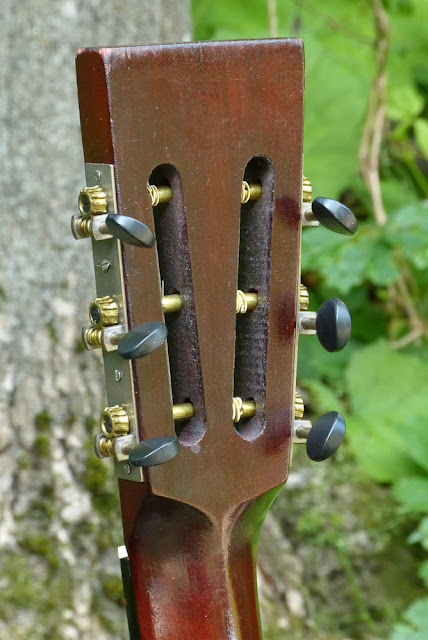1920s Oscar Schmidt "Stella" Tailpiece Parlor Guitar
Here's a sweetie: a real clean "decalcomania" Stella from the 20s! This is a customer's instrument that was in for work and it sure scratches that country-blues itch. Work included a neck reset, fret level/dress, a new nut, seam repairs, and general setup.
I've now worked on this same model for the third time -- and there's another of the same guitar squirreled away in the workshop racks, too. This one is the cleanest one I've seen, though, and the decals and finish practically glow. This would make any bluesman proud!
It's an 0-size "parlor" guitar and has solid birch all over the body. The top edge is bound in celluloid and the fretboard is dyed maple while the neck seems to be poplar. This is all pretty standard-fare for an old Stella, but the tailpiece-loaded design is a little less common -- especially with the super-cool "post" version of this tailpiece. I like those posts because they let you deflect string angles to set your bridge tension the way you want it.
The "Stella" is loud and proud on the headstock.
I've strung the guitar up with 50w-11 strings to take it easy on the neck. These guitars have 25" scales, generally (this one does), which puts plenty of tension on the lightly-braced tops these also (generally) have.
This guitar is loud and snappy and, in a pinch, could plunk out jazz rhythm.
I love the wildly overpowering floral display on this one.
The original bridge is a terrible design, but thankfully its back edge (used originally just for spacing the strings) was made useful as the new "saddle" area of the bridge. I filled in the old slots, compensated the B-string slot (as well as possible), and set it up using the back edge as the "breaking point" for the strings. My neck reset gave plenty of height over the body so this made that adjustment practical.
It also keeps the "look" original from anywhere but the player's point of view (as the brass fret-saddle no longer does anything -- the strings are over it).
She's a beaut!














Comments